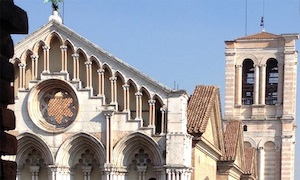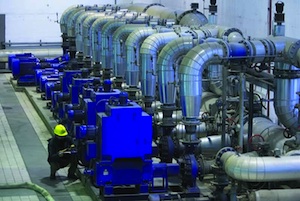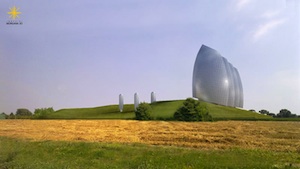Geothermal and waste energy sources
Ferrara, City of the Renaissance, and its Po Delta, with an area of 46,712 a, was inscribed on the World Heritage List in 1995. The humanist concept of the ‘ideal city’ came to life here in the neighbourhoods built from 1492 onwards by Biagio Rossetti according to the new principles of perspective. The completion of this project marked the birth of modern town planning and influenced its subsequent development. Today Ferrara continues in this creative spirit in such fields as energy.
Ferrara is one of the most sustainable cities of Italy and environmental issues are seriously taken into account by the Municipality. It subscribed the Aalborg chart in 1996 et en 1998 il a commencé l'Agenda local 21 processus. It has also been awarded by Legambiente (l'agence de l'environnement italien) comme meilleure ville respectueuse de l'environnement dans 2001. The municipality is member of several Italian and European networks of sustainable cities (ICLEI, BigNet, and Car Free Cities) and is signatory of EU’s Covenant of Mayors.
The Geothermal Project
The use of geothermal energy as energy source starts with its discovery in 1956, during explorations for oil reservoirs at a depth of 1,000 m, 4 km NW du centre-ville de Ferrare. At that time the well was abandoned and only after the energy crisis of the 70’s it was taken again into account, to utilize this important energy source.
Recent geo-structural and geothermal investigations carried out by HERA Group (Energy Resources Environment Holdings) in collaboration with the University of Ferrara and the Emilia-Romagna Region, confirm the presence of geothermal reservoirs in the east part of Ferrara. Three hydrothermal systems have been identified. Each reservoir can be considered hydraulically separated from the others by aquitards that prevent significant leakages.
At the beginning of the 80’s, the Municipality of Ferrara developed a Geothermal Project in order to exploit this resource as a primary source for an urban heating system and to reduce, in a solid way, the environmental impact created by the traditional energy sources (coke, oil and methane gas, etc…).
Au début, le fluide géothermique (l'eau chaude, ca 100°C) est pompée à une profondeur de 1,000 m de la surface; transfère l'eau chaude, puis l'énergie thermique à l'installation de chauffage. Enfin, il est réintroduit dans le sous-sol afin d'assurer la stabilité géotechnique.
Les travaux ont débuté en 1987 et en 1990 les premiers bâtiments ont été raccordés au réseau de chauffage urbain. En 1993 l'installation de cogénération pour la thermo-destruction des déchets solides a été construit, tandis qu'un deuxième puits a été ouvert en 1995. En 1999 un turbo-alternateur alimenté par la vapeur générée par la centrale de cogénération a été installé. At the end of 2010 the installed geothermal power was about 23 MWt.
Système intégré de l'énergie
Maintenant, le réseau de Ferrara est alimenté par le soi-disant «système d'énergie intégré", because the energy from the Waste Treatment Plant was added to the geothermal source. Ce système présente plus d'avantages environnementaux et économiques que le traditionnel car il permet d'avoir d'importantes économies et de réduire les émissions de CO2.
The system incorporates geothermal sources, CHP (combined heat and power) units installed in the solid waste processing plants, together with boilers running on biogas and used as backup systems. The urban heating network supplies the equivalent of 22,000 housing units, mostly in private and public buildings.
But the future is more promising. The proposed new Renewable Energy Hub will allow increasing this figure to 37,000 housing units, meaning that the district heating would cover the 40% of households. Another new development is that solar thermal will be incorporated to geothermal, with the capacity to convert solar energy into thermal energy for heating with a power of 1 MWt.
The energy mix will reach 90% of renewables. With the new Hub, 56.4% of the energy in the grid will come from geothermal sources, 34.3% from the Cassana incinerator, exploiting energy from waste and agricultural biomass, 0.3% from solar thermal, and only 9% from natural gas, the only non-renewable source.
Canada
The District Heating System of Ferrara represents one of the most important examples of ‘Integrated Energy System’ that will be further increased by the future development. Grâce à sa haute efficacité énergétique de ce système est pensé pour être très utile et transférable bien que certains problème peut être lié à la taille de construction requis, liée au marché, et des raisons économiques et techniques.


















